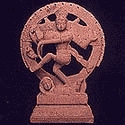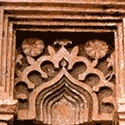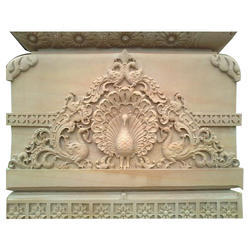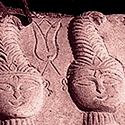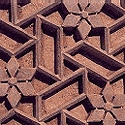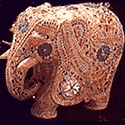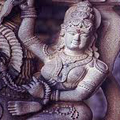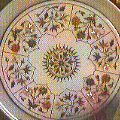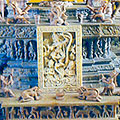Sozni embroidery of Kashmir,
Sozani (or suzani) embroidery is a style of embroidery from the Jammu and Kashmir region of northwest India. The motifs are created in satin stitch and are identical on both sides of the cloth, through sometimes the colours are different; for example, the dominant colour could be red on one side and blue on the other. This type of work/stitch is sometimes called “dorukha”. The most popular motifs consist of abstract geometrical designs, stylized flowers, as well as paisley patterns. They are normally worked in one or two colours, or very occasionally in three colours. Sometimes the ground cloth is woven in such a manner (such as with a compound weave) that it has different dominant colours on either side of the material to complement the different colours of the embroidery threads. Sozani embroidery is, among others, used especially to decorate shawls, and for the panels along the side of the cloth. Mainly carried out on Pashmina and high quality raffal, Sozni is an absolutely fine and delicate needlework. The placing of the design and motifs are extremely close in proximity and smaller stitches are reinforced with individual threads of the warp. Shawls and garments are produced used this needle work.
Sozani (or suzani) embroidery is a style of embroidery from the Jammu and Kashmir region of northwest India. The motifs are created in satin stitch and are identical on both sides of the cloth, through sometimes the colours are different; for example, the dominant colour could be red on one side and blue on the other. This type of work/stitch is sometimes called “dorukha”. The most popular motifs consist of abstract geometrical designs, stylized flowers, as well as paisley patterns. They are normally worked in one or two colours, or very occasionally in three colours. Sometimes the ground cloth is woven in such a manner (such as with a compound weave) that it has different dominant colours on either side of the material to complement the different colours of the embroidery threads. Sozani embroidery is, among others, used especially to decorate shawls, and for the panels along the side of the cloth. Mainly carried out on Pashmina and high quality raffal, Sozni is an absolutely fine and delicate needlework. The placing of the design and motifs are extremely close in proximity and smaller stitches are reinforced with individual threads of the warp. Shawls and garments are produced used this needle work.
Stone Carving of Andhra Pradesh/Telangana,
Durgi stone craft hails from the temple town village of Durgi in the Palnadu region of Guntur, Andhra Pradesh. These are intricate stone carvings made from a special kind of lime stone which is native to the region. The craft originated at Durgi in the 15th century and has flourished since then. At that time, sculptors realized the potential in using limestone over expensive marble and granite, giving birth to a new form of craft. The soft, whitish gray texture of the stone makes it ideal for creating ornamental sculptures of gods and goddesses. The craftsmen follow traditional carving techniques according to the Shilp Shastras. Today, a wide range of products are curated in order to expand the commercial reach of this craft. Apart from auspicious idols and statues, beautiful decor items are made using stone carvings. The Allagadda town in Andhra Pradesh is regarded as an important center for sculptural stone carving craft. The sculptures crafted here are made from locally obtained sand stone which is heat resistant and durable. It is generally brown or yellow in color and its composition is such that it permits for intricate carving and detailing. Figurines of gods and goddesses are sculpted by strictly following the ancient Shilp Shastra manuscripts in the Vijayanagara style. Another variant of stone which is used in Allagadda to craft sculptures is the tough black-stone that varies in shade from grey to black and is customarily used to make idols of Lord Krishna. The craftspersons have extended their repertoire beyond sculptures of gods and goddesses to include items of decorative interior decor.
Durgi stone craft hails from the temple town village of Durgi in the Palnadu region of Guntur, Andhra Pradesh. These are intricate stone carvings made from a special kind of lime stone which is native to the region. The craft originated at Durgi in the 15th century and has flourished since then. At that time, sculptors realized the potential in using limestone over expensive marble and granite, giving birth to a new form of craft. The soft, whitish gray texture of the stone makes it ideal for creating ornamental sculptures of gods and goddesses. The craftsmen follow traditional carving techniques according to the Shilp Shastras. Today, a wide range of products are curated in order to expand the commercial reach of this craft. Apart from auspicious idols and statues, beautiful decor items are made using stone carvings. The Allagadda town in Andhra Pradesh is regarded as an important center for sculptural stone carving craft. The sculptures crafted here are made from locally obtained sand stone which is heat resistant and durable. It is generally brown or yellow in color and its composition is such that it permits for intricate carving and detailing. Figurines of gods and goddesses are sculpted by strictly following the ancient Shilp Shastra manuscripts in the Vijayanagara style. Another variant of stone which is used in Allagadda to craft sculptures is the tough black-stone that varies in shade from grey to black and is customarily used to make idols of Lord Krishna. The craftspersons have extended their repertoire beyond sculptures of gods and goddesses to include items of decorative interior decor.
Stone Carving of Bihar,
Stone carving is a very ancient tradition in Bihar and ancient techniques of polishing can still be seen in the Ashoka pillar at Sarnath. This is made of black stone and has a striking green lustre. Stone carvers are mainly concentrated in Patharkatti in Gaya district and in Chandil and Karaikalla in Singhbhum district. Among the articles that are carved are stone deities to be worshipped in temples and homes, as well as a variety of products for everyday use. The include thalis or large plates, bowls, grinding containers, and glasses. Black stone artisans of Gaya in Bihar are also famous. Legend has it that 400 years ago, Rani Ahilyabai Holkar called the Gaur brahmin stone-cutters of Rajasthan to build the Vishnapad temple in black stone in Gaya. These craftspersons took on local apprentices for the work. The raja of that area was so impressed with the quality of their work that he offered them land to live on as well as a stone quarry nearby. Today numerous utility articles in stone of various colours are being made in Gaya town.
Stone carving is a very ancient tradition in Bihar and ancient techniques of polishing can still be seen in the Ashoka pillar at Sarnath. This is made of black stone and has a striking green lustre. Stone carvers are mainly concentrated in Patharkatti in Gaya district and in Chandil and Karaikalla in Singhbhum district. Among the articles that are carved are stone deities to be worshipped in temples and homes, as well as a variety of products for everyday use. The include thalis or large plates, bowls, grinding containers, and glasses. Black stone artisans of Gaya in Bihar are also famous. Legend has it that 400 years ago, Rani Ahilyabai Holkar called the Gaur brahmin stone-cutters of Rajasthan to build the Vishnapad temple in black stone in Gaya. These craftspersons took on local apprentices for the work. The raja of that area was so impressed with the quality of their work that he offered them land to live on as well as a stone quarry nearby. Today numerous utility articles in stone of various colours are being made in Gaya town.
Stone Carving of Chattisgarh,
The pink and white stone available in Bastar called sudapaal is soft and easily carved. Large tool called basulas are used for cutting the stone. Pataasis or chisels of various shapes and sizes are used for finer carvings. The artisan make free-hand carvings with these chisels, embellishing the basic motifs with intricate detailing. The idols are later polished with sandpaper to give them a sheen. Tatiya saaj idols are carved on a thick rock as two-dimensional relief work while akshang idols are three dimensional. There are no prescribed measurements: the artisans cut, shape, and carve the idols from an inherent sense of proportion and experience. Simple tools of measurement like the guniya or compass are used. When completed, the idols are polished with polishing stones called battas. The polishing is done mainly by women and children. At Sheopur, a very traditional form of stone craft is practised in which tribal artisans decorate door frames with intricate creeper designs and also make idols of the gods Hanuman, Ganesh, and Shiva, and of the goddess Parvati. The folk idols of Rajasthan, Pabuji and Tejaji are also sculpted and worshipped as gods. These idols are made on platforms at vantage points in villages. They are are crafted at Ratlam, Kukshi, Mandsaur, and in several other parts of the state. The craftspersons of Kailavan and Tikamgarh also make figures of wild animals.
The pink and white stone available in Bastar called sudapaal is soft and easily carved. Large tool called basulas are used for cutting the stone. Pataasis or chisels of various shapes and sizes are used for finer carvings. The artisan make free-hand carvings with these chisels, embellishing the basic motifs with intricate detailing. The idols are later polished with sandpaper to give them a sheen. Tatiya saaj idols are carved on a thick rock as two-dimensional relief work while akshang idols are three dimensional. There are no prescribed measurements: the artisans cut, shape, and carve the idols from an inherent sense of proportion and experience. Simple tools of measurement like the guniya or compass are used. When completed, the idols are polished with polishing stones called battas. The polishing is done mainly by women and children. At Sheopur, a very traditional form of stone craft is practised in which tribal artisans decorate door frames with intricate creeper designs and also make idols of the gods Hanuman, Ganesh, and Shiva, and of the goddess Parvati. The folk idols of Rajasthan, Pabuji and Tejaji are also sculpted and worshipped as gods. These idols are made on platforms at vantage points in villages. They are are crafted at Ratlam, Kukshi, Mandsaur, and in several other parts of the state. The craftspersons of Kailavan and Tikamgarh also make figures of wild animals.
Stone Carving of Gujarat,
In this craft, rough stones hewn from quarries are transported to the work site. The stone is cut to suitable sizes and outlines of the desired designs are marked with the help of geru or red oxide mixed with water. The sompura community of stone-carvers from Wadhwan in Kathiawar created the farmed Somnath and Dwarka temples. The carved stone brackets on the facades of old houses and temples in Gujarat are also the handiwork of the sompura community. Gujarat is famous for building structures for various utilarian purposes as well. Water structures, ritualistic spaces, funerary structures, forts and palaces. The stone carving techniques have evolved through time. One of the most intricate examples of stone carving craft in Gujarat is the jaali/ fretwork. Detailed and delicate work is also done on jhorukhas/balcony , chajjas/ ceilings and stambhas/pillars. [gallery ids="176480,176481,176482"]
In this craft, rough stones hewn from quarries are transported to the work site. The stone is cut to suitable sizes and outlines of the desired designs are marked with the help of geru or red oxide mixed with water. The sompura community of stone-carvers from Wadhwan in Kathiawar created the farmed Somnath and Dwarka temples. The carved stone brackets on the facades of old houses and temples in Gujarat are also the handiwork of the sompura community. Gujarat is famous for building structures for various utilarian purposes as well. Water structures, ritualistic spaces, funerary structures, forts and palaces. The stone carving techniques have evolved through time. One of the most intricate examples of stone carving craft in Gujarat is the jaali/ fretwork. Detailed and delicate work is also done on jhorukhas/balcony , chajjas/ ceilings and stambhas/pillars. [gallery ids="176480,176481,176482"]
Stone Carving of Himachal Pradesh,
The stone craftspersons of Himachal Pradesh belong to the batada or the bataihra community. Himachal has a fair variety of stone used for carving and construction. For building purposes, rubble masonry is used while sand stone is used for carving relief structural panels for temples. Good quality lime stone is available in Kangra, Mandi, Bilaspur, and Kulu and is used mainly for utilitarian objects. The traditional centres for carving are Kangra, Mandi, Bilaspur, Sirmaur, Chamba, and Kulu. The traditional stone-carvers in the Dehlu village of Mandi chisel two- dimensional images of Deot Siddha, a popular demi-god worshipped in Mandi. They also carve large lingayoni stones to install in the temples. Domestic products like stoves, angithis, flour-mill stones, kundis, pestle and mortar sets, dauri danda, mill stones, and chakkis are still made all over the state. Fountain stones, locally called panihas, and erected to commemorate the death of a king, village hero, warrior, or clan ancestor are a common sight in Chamba and Mandi. They are probably referred to as fountain stones owing to their proximity to water springs or a temple complexes.
The stone craftspersons of Himachal Pradesh belong to the batada or the bataihra community. Himachal has a fair variety of stone used for carving and construction. For building purposes, rubble masonry is used while sand stone is used for carving relief structural panels for temples. Good quality lime stone is available in Kangra, Mandi, Bilaspur, and Kulu and is used mainly for utilitarian objects. The traditional centres for carving are Kangra, Mandi, Bilaspur, Sirmaur, Chamba, and Kulu. The traditional stone-carvers in the Dehlu village of Mandi chisel two- dimensional images of Deot Siddha, a popular demi-god worshipped in Mandi. They also carve large lingayoni stones to install in the temples. Domestic products like stoves, angithis, flour-mill stones, kundis, pestle and mortar sets, dauri danda, mill stones, and chakkis are still made all over the state. Fountain stones, locally called panihas, and erected to commemorate the death of a king, village hero, warrior, or clan ancestor are a common sight in Chamba and Mandi. They are probably referred to as fountain stones owing to their proximity to water springs or a temple complexes.
Stone Carving of Madhya Pradesh,
In Madhya Pradesh, domestic implements like the mortar and pestle, the silbatta, chabbi, kundi khoral, handi, and chakla are made by the tribals. These products are lightly carved with designs. Chakkis occupy an important position in Indian traditions as they are believed to keep away evil spirits. The soft marble rocks surrounding Bhedaghat near Jabalpur offer pliable raw material for making decorative objects like carved panels, figures, and boxes. Balaghat has a green stone out of which local carvers make a number of small items. Religious images are important. The Ghosipura area of Gwalior is situated on a hill and has a number of sculptors residing there. They are popularly known as descendants of Vishwakarma and the price they fix for an idol is called wyochhar. This is fixed at an odd number value as the number 'one' is considered to be very auspicious. In the Bamaur area five types of stones are available, of which the rajauri is the most durable. Singi is the most suitable for carving idols and dauver is used to make lattices. Mandsaur, Ratlam, and Narsinghagarh specialise in stone craft. Lord Deo Narayan, a popular deity of Mandsaur, is beautifully crafted, while the sculptures found in Umrali village are made of yellow sand stone and are not very large.
In Madhya Pradesh, domestic implements like the mortar and pestle, the silbatta, chabbi, kundi khoral, handi, and chakla are made by the tribals. These products are lightly carved with designs. Chakkis occupy an important position in Indian traditions as they are believed to keep away evil spirits. The soft marble rocks surrounding Bhedaghat near Jabalpur offer pliable raw material for making decorative objects like carved panels, figures, and boxes. Balaghat has a green stone out of which local carvers make a number of small items. Religious images are important. The Ghosipura area of Gwalior is situated on a hill and has a number of sculptors residing there. They are popularly known as descendants of Vishwakarma and the price they fix for an idol is called wyochhar. This is fixed at an odd number value as the number 'one' is considered to be very auspicious. In the Bamaur area five types of stones are available, of which the rajauri is the most durable. Singi is the most suitable for carving idols and dauver is used to make lattices. Mandsaur, Ratlam, and Narsinghagarh specialise in stone craft. Lord Deo Narayan, a popular deity of Mandsaur, is beautifully crafted, while the sculptures found in Umrali village are made of yellow sand stone and are not very large.
Stone Carving of Rajasthan,
Stone-carving is mainly found at Jaipur, Thanagazi, Kishori Makrana, Jodhpur, Jaisalmer, and Dungarpur. The fine stone-carving or delicate jali work in stone is very distinctive of this area. Functional domestic ware in stone is beautifully shaped and ornamented. The main stone found here is the yellow lime stone, sand stone, and coloured and white marble. In the panels made of stone, relief work is combined with trellis work. Sand stone is finely chiselled as if it were wood. Stone carving is practiced widely in Jaisalmer of Rajasthan. Products such as overhang or chhajja, window or jharokha, pillar capital or monjisha, lattice worked screen or jaali, window ledge or kangra, arches or mihrab, tables, lamp stands, platform for rolling flatbread or chakla, tumblers, plates and pen stands are produced under this craft-form. Tools such as hammers, chisel, thin chisel, thick chisel, fine chisel, brush and metal stencil are used for the production process. Stone carving in buildings take the form of elegantly carved pillars, complicated pierced facades, screens with traceries, and richly carved doors ornamented with brass motifs. The structures have fine proportions and harmony. The green-spotted copper coloured tamra stone found in Sawaimadhopur is used in making images. Dungarpur has a soft shaded stone which turns black when oiled and is used for icon-making. A special feature is the carving of the Sun God, not found in other parts of Rajasthan. A soft stone in Bhilwara is very pliable and it is used as a substitute for alabaster.
Stone-carving is mainly found at Jaipur, Thanagazi, Kishori Makrana, Jodhpur, Jaisalmer, and Dungarpur. The fine stone-carving or delicate jali work in stone is very distinctive of this area. Functional domestic ware in stone is beautifully shaped and ornamented. The main stone found here is the yellow lime stone, sand stone, and coloured and white marble. In the panels made of stone, relief work is combined with trellis work. Sand stone is finely chiselled as if it were wood. Stone carving is practiced widely in Jaisalmer of Rajasthan. Products such as overhang or chhajja, window or jharokha, pillar capital or monjisha, lattice worked screen or jaali, window ledge or kangra, arches or mihrab, tables, lamp stands, platform for rolling flatbread or chakla, tumblers, plates and pen stands are produced under this craft-form. Tools such as hammers, chisel, thin chisel, thick chisel, fine chisel, brush and metal stencil are used for the production process. Stone carving in buildings take the form of elegantly carved pillars, complicated pierced facades, screens with traceries, and richly carved doors ornamented with brass motifs. The structures have fine proportions and harmony. The green-spotted copper coloured tamra stone found in Sawaimadhopur is used in making images. Dungarpur has a soft shaded stone which turns black when oiled and is used for icon-making. A special feature is the carving of the Sun God, not found in other parts of Rajasthan. A soft stone in Bhilwara is very pliable and it is used as a substitute for alabaster.
Stone Carving of Uttar Pradesh,
Eastern Uttar Pradesh has rich deposits of beautiful soft stone and it has spawned a sizeable stone-carving industry, the main centre for which is Varanasi where stone-carving artisans belong to a community called the raidas. The main products produced here are table ware, plates, glasses, bowls, food-containers, and candle stands. Power operated machines are used and the stone is many hued with a lovely red shade. The articles are simple, but well made. The Taj Mahal represents the highest glory of artistry in inlaid work in the 16th and 17th century. The art involved carving out floral and geometrical patterns on the creamy-white marble surface. Agra's flourishing industry draws inspiration from the Taj Mahal. Miniature models of the Taj Mahal are made in abundance. Other items which are popular include vases, boxes, lamps, plates, bowls, and pitchers that combine delicately moulded shapes, fine carving, and exquisite decorations set off sometimes by perforated traceries revealing subtle designs. The mosaics are incomparable: the milky-white background surface highlights the numerous coloured stones. The design patterns used are mostly foliage and floral motifs intertwined with geometrical patterns. The typical Mughal influence is seen in the flow of lines and the refined taste, reminiscent of damascening. Originally, precious stones were used in the mosaics, but today semi-precious stones are used. The wide selection of articles made out of mosaic-marble includes household articles like jewellery, trinket and powder boxes, trays, and tableware; the furniture items include settees with latticed backs, armchairs, table tops and panels. Vrindavan, near Mathura, gets its marble from Rajasthan, black stone from Bihar, green stone from Madhya Pradesh and so on. Some of the items are embossed with semi-precious stones or cheaper synthetic gems. Since this place is closely associated with Lord Krishna, a lot of his images are made. A dark-brown stone with yellow spots called sange-rathek is found in Jhansi and its surrounding areas from which lamp-shades, incense-stick stands, and small medicine-grinders are made.
Eastern Uttar Pradesh has rich deposits of beautiful soft stone and it has spawned a sizeable stone-carving industry, the main centre for which is Varanasi where stone-carving artisans belong to a community called the raidas. The main products produced here are table ware, plates, glasses, bowls, food-containers, and candle stands. Power operated machines are used and the stone is many hued with a lovely red shade. The articles are simple, but well made. The Taj Mahal represents the highest glory of artistry in inlaid work in the 16th and 17th century. The art involved carving out floral and geometrical patterns on the creamy-white marble surface. Agra's flourishing industry draws inspiration from the Taj Mahal. Miniature models of the Taj Mahal are made in abundance. Other items which are popular include vases, boxes, lamps, plates, bowls, and pitchers that combine delicately moulded shapes, fine carving, and exquisite decorations set off sometimes by perforated traceries revealing subtle designs. The mosaics are incomparable: the milky-white background surface highlights the numerous coloured stones. The design patterns used are mostly foliage and floral motifs intertwined with geometrical patterns. The typical Mughal influence is seen in the flow of lines and the refined taste, reminiscent of damascening. Originally, precious stones were used in the mosaics, but today semi-precious stones are used. The wide selection of articles made out of mosaic-marble includes household articles like jewellery, trinket and powder boxes, trays, and tableware; the furniture items include settees with latticed backs, armchairs, table tops and panels. Vrindavan, near Mathura, gets its marble from Rajasthan, black stone from Bihar, green stone from Madhya Pradesh and so on. Some of the items are embossed with semi-precious stones or cheaper synthetic gems. Since this place is closely associated with Lord Krishna, a lot of his images are made. A dark-brown stone with yellow spots called sange-rathek is found in Jhansi and its surrounding areas from which lamp-shades, incense-stick stands, and small medicine-grinders are made.
Stone Carving of Uttrakhand,
Main sites for stone carvings of Uttarakhand can be found in its temple architecture. Temples in this region are decorated with big heavy and intricate stone carvings. Stone carvings of this region were patronized by rich and powerful kings of Katuyaris, Paun, Chanda and Pawars dynasties. Baleshwar, Kedarnath, Jageshwar, Bageshwar, Panch Kedar, and Almora showcase some extraordinary examples of this craft. The craft is still being practiced in the region.
Main sites for stone carvings of Uttarakhand can be found in its temple architecture. Temples in this region are decorated with big heavy and intricate stone carvings. Stone carvings of this region were patronized by rich and powerful kings of Katuyaris, Paun, Chanda and Pawars dynasties. Baleshwar, Kedarnath, Jageshwar, Bageshwar, Panch Kedar, and Almora showcase some extraordinary examples of this craft. The craft is still being practiced in the region.
Stone Craft of Pakistan,
Pakistan's tradition of stone carving stretches back into history Sandstone, onyx, slate, marble and limestone are some of the varieties used by the artisans. The earliest Arabs to arrive in Sindh brought the art of calligraphy in stone and tombs that were built between the eighth and the eighteenth century carry finely carved verses from the Quran on them. Decorative motifs and arabesque patterns were finely carved. Combined with the already popular floral motifs, like the sunflower and the lotus, these new forms produced a rich variety of designs for which a large body of stone structures in Thatta are famous.
Pakistan's tradition of stone carving stretches back into history Sandstone, onyx, slate, marble and limestone are some of the varieties used by the artisans. The earliest Arabs to arrive in Sindh brought the art of calligraphy in stone and tombs that were built between the eighth and the eighteenth century carry finely carved verses from the Quran on them. Decorative motifs and arabesque patterns were finely carved. Combined with the already popular floral motifs, like the sunflower and the lotus, these new forms produced a rich variety of designs for which a large body of stone structures in Thatta are famous.
MARBLE AND SANDSTONE
The most outstanding workmanship of the period is in marble. No visitor to the Shish Mahal in the Fort can fail to be wonder struck by the magnificent pietra dura work there. In some of the miniature niches - two and a quarter inches by one and three fourths of an inch - of half pillars one can count more than a hundred pieces of semi precious stone inlaid to form a single floral pattern. Also notable for their excellence and variety of patterns are the marble screens /jalli used for windows and the geometric and tendril designs.
In the recent past the use of sandstone in buildings declined and with it the scope for craftsmen to carve and engrave stone for architectural embellishment. However, substantial increase in the availability of marble has opened new opportunities for stone craftsmen. Although it is in the form of plain slabs that marble is mostly used in buildings, stone carvers are called in to make latticed grills and screens for newly constructed mosques.
ONYX
Pakistani craftsmen have excelled in crafting onyx in a hundred shapes. Extracted from the mountains in the NWFP and the brown hills of Balochistan, especially around Chaghai, Pakistan's onyx is counted among the finest found anywhere in the world. It is now available in several colours and shades-off-white, deep brown, pink and jade green. Very often the veins running in a colour different than the ground give an onyx piece a natural pattern that would arouse the envy of a modern painter.
Stone Icon Carving of Andhra Pradesh/Telangana,
Carving in Andhra Pradesh dates back to 1000 BC when Buddhism was at a peak. Under Satvahana, Amravati emerged as a centre that even till date testifies the magnificent Buddhist, Hindu and Islamic architecture that was evolved during that time. The state has vast deposits of granite and the abundance ensures the craft to thrive till date. Extensively a temple based industry; Krishnashila is the most common material for stone idol carving. Different production clusters are located in Kurnool, Guntur and Warangal districts. Other than idols, pillar carving is also incorporated in the temples around the city.
Carving in Andhra Pradesh dates back to 1000 BC when Buddhism was at a peak. Under Satvahana, Amravati emerged as a centre that even till date testifies the magnificent Buddhist, Hindu and Islamic architecture that was evolved during that time. The state has vast deposits of granite and the abundance ensures the craft to thrive till date. Extensively a temple based industry; Krishnashila is the most common material for stone idol carving. Different production clusters are located in Kurnool, Guntur and Warangal districts. Other than idols, pillar carving is also incorporated in the temples around the city.
Stone Icon Carving of Karnataka,
In Karnataka, a Hoysala stone sculptor draws his creative technique from the wisdom of centuries. He is taught to identify stones on the basis of the sound they emit when beaten, and the different uses are also made clear to him: 'male stones' are used for sculpting gods, 'female stones' for goddesses, and 'neutral stones' for objects. Rules pertaining to proportions, postures, and ornamentation laid down by the Dhyanashlokas are meant to be followed. After the raw stone is selected and sized, a sketch of the proposed image is drawn on to it. This is realised roughly with the help of steel rods and mallets. The sculpture is brought to its final form with chisels of varied sizes and its roughness is polished away with files of increasing sharpness. The final image is then smoothened with sandpaper and rubbed with coconut oil.
In Karnataka, a Hoysala stone sculptor draws his creative technique from the wisdom of centuries. He is taught to identify stones on the basis of the sound they emit when beaten, and the different uses are also made clear to him: 'male stones' are used for sculpting gods, 'female stones' for goddesses, and 'neutral stones' for objects. Rules pertaining to proportions, postures, and ornamentation laid down by the Dhyanashlokas are meant to be followed. After the raw stone is selected and sized, a sketch of the proposed image is drawn on to it. This is realised roughly with the help of steel rods and mallets. The sculpture is brought to its final form with chisels of varied sizes and its roughness is polished away with files of increasing sharpness. The final image is then smoothened with sandpaper and rubbed with coconut oil.
Stone Icon Carving of Kerala,
Stone carving has a very ancient history in Kerala. Sculptures belonging to the historic period date back to the ancient times. The community that makes the images is known as Kallasari -one of the five Kamalas. The Padmanabhaswami Temple in Trivandrum is a storehouse of fine sculpture. Kerala is rich in granite and laterite rocks, though granite is largely used in image-making for which Changanur is an important centre. The special variety of stone used for image-making is known as Krishna-shila which is available at Omalur in Pathanamthitta district and Trithala near Pattambi. The tools used include hammer and chisels. The polishing is done with sealing wax and steel powder which are melted and moistened. Laterite, the red muddy stone that is abundantly available throughout Kerala, was widely used to build both domestic structures and temples such as the Mahadeva temple at Kazhakuttam and the Vaddakkunathan Temple at Thrissur. Although soft when quarried, the materials rapidly hardens on coming into contact with the elements, forming into a highly durable and strong construction materials. Further, the stone is somewhat porous, allowing the rock to 'breathe' in the humid tropical heat. Other products made include fence walls, tombstones, oil lamps of a wide variety, stone grinders, etc. Production takes place in Kurukanpara in Thrissur district; Ottapalam in Palakkad district; Patuvur in Ernakulam district; Chengannur in Alappuzha district; and in Thiruvananthapuram.
Stone carving has a very ancient history in Kerala. Sculptures belonging to the historic period date back to the ancient times. The community that makes the images is known as Kallasari -one of the five Kamalas. The Padmanabhaswami Temple in Trivandrum is a storehouse of fine sculpture. Kerala is rich in granite and laterite rocks, though granite is largely used in image-making for which Changanur is an important centre. The special variety of stone used for image-making is known as Krishna-shila which is available at Omalur in Pathanamthitta district and Trithala near Pattambi. The tools used include hammer and chisels. The polishing is done with sealing wax and steel powder which are melted and moistened. Laterite, the red muddy stone that is abundantly available throughout Kerala, was widely used to build both domestic structures and temples such as the Mahadeva temple at Kazhakuttam and the Vaddakkunathan Temple at Thrissur. Although soft when quarried, the materials rapidly hardens on coming into contact with the elements, forming into a highly durable and strong construction materials. Further, the stone is somewhat porous, allowing the rock to 'breathe' in the humid tropical heat. Other products made include fence walls, tombstones, oil lamps of a wide variety, stone grinders, etc. Production takes place in Kurukanpara in Thrissur district; Ottapalam in Palakkad district; Patuvur in Ernakulam district; Chengannur in Alappuzha district; and in Thiruvananthapuram.
Stone Icon Carving of Odisha,
The tradition of stone-carving is very rich in Odisha. The craftspersons of the Kalinga School have built masterpieces like the Sun Temple, Konark, and the temples at Bhuvaneshwar. Puri is an important centre for stone-carving. Soap stone, red sand stone, and granite are used for carving. Patharasahi is another important stone-cutting and stone-carving centre. Puri specialises in icons and figures carved in different dance poses. A variety of household products are made from sand stone while granite is used to make images modelled on temple figures. Cooking utensils are usually made in sand stone. They are often made on a machine but finished by hand.
The tradition of stone-carving is very rich in Odisha. The craftspersons of the Kalinga School have built masterpieces like the Sun Temple, Konark, and the temples at Bhuvaneshwar. Puri is an important centre for stone-carving. Soap stone, red sand stone, and granite are used for carving. Patharasahi is another important stone-cutting and stone-carving centre. Puri specialises in icons and figures carved in different dance poses. A variety of household products are made from sand stone while granite is used to make images modelled on temple figures. Cooking utensils are usually made in sand stone. They are often made on a machine but finished by hand.

